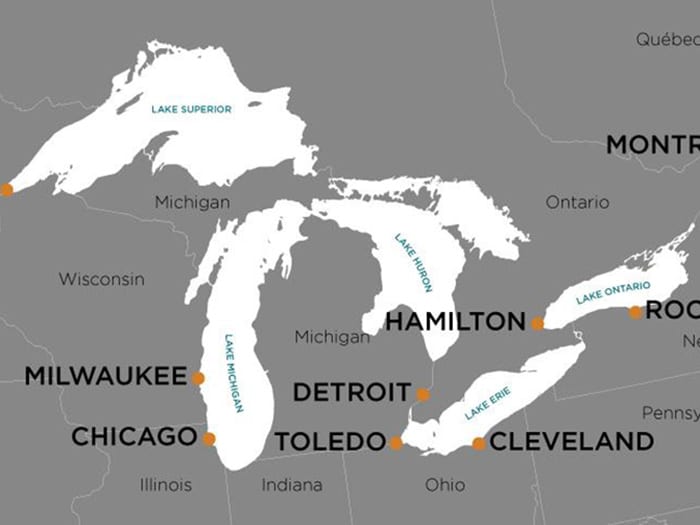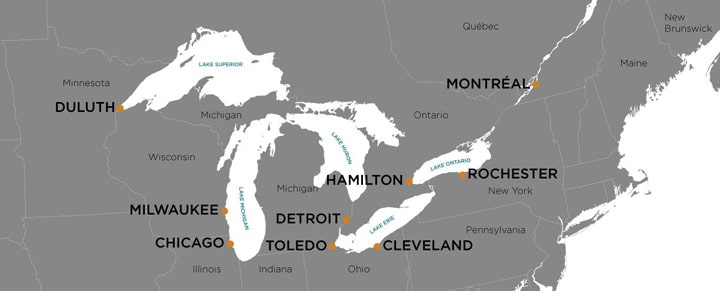
Study sees Canada-U.S. Great Lakes short-sea shipping opportunities
Written by Nick Blenkey
The U.S-Canada Great Lakes region. Ready for short-sea shipping?
A new study sees significant potential advantages for short-sea shipping services between southern Ontario, Canada, and the U.S. Great Lakes region. The study was carried out by Fluid Intelligence, a data-analysis partnership of the Hamilton Ontario Port Authority (HOPA Ports) and the McMaster Institute for Transportation & Logistics, with support from Transport Canada. It highlights the numerous trade flows that could benefit from integrating marine transportation alongside trucking services.
Currently, over 12,000 trucks per week make cross-border trips between Southern Ontario and U.S. Great Lakes port areas, carrying non-perishable commodities that are seen as ideal candidates for a marine service to handle the long-haul “middle mile.”
Short-sea shipping, a widely adopted approach in Europe and Asia, is an increasingly appealing alternative to road transportation in the Great Lakes region. Factors such as population growth, highway congestion, driver shortages, and rising fuel costs have contributed to a growing interest in marine transportation. Importantly, short sea shipping offers a significant environmental advantage, as one marine vessel can carry the same cargo capacity as 963 transport trucks, while emitting just 15% of the CO2 per metric tonne/km.
As Canada’s busiest economic region, southern Ontario’s critical infrastructure struggles to keep up with the demand on its highways. Issues such as highway congestion, border delays, lack of transportation redundancy, and truck driver shortages have been exacerbated by population growth and density. The economic cost of congestion in the GTHA (Greater Toronto and Hamilton, Ontario, Area) alone is estimated to be up to $6 billion per year.

The Great Lakes Region accounts for more than 50% of all U.S./Canadian bilateral border trade. If it were a single country, it would have a GDP of US$6 trillion, making it the third biggest economy in the world.
Approximately 28.5 million tonnes of cargo per year originating in Ontario are transported by truck to the U.S., with 70% destined for a Great Lakes State. Conversely, at least 24 million tonnes of cargo per year originate in the US and move by truck into Ontario, with 55% originating in a Great Lakes State.
The study focuses on specific routes and commodity flows seen as excellent candidates for new marine services. These include the potential for marine services between southern Ontario and ports on Lake Michigan and Lake Erie. In particular, the cities of Chicago and Milwaukee are promising due to the concentration of economic activity and strong connections to Southern Ontario population centers
Overall, there are approximately 5,000 (within a 30-mile radius) and 12,000 (within a 60-mile radius) truck trips per week between five U.S.- Great Lakes ports and southern Ontario, all of which present excellent opportunities for modal alternatives.
By diverting just 10% of the existing cargo currently moved by truck between southern Ontario and the Port of Chicago, for example, the transportation system could save 220 tonnes of greenhouse gas emissions per week.
“Short-sea shipping is an idea whose time has come,” says Ian Hamilton, president & CEO, HOPA Ports. “This study gives us the real data we need to identify the most promising commodities and routes, where marine transportation can help address our mounting goods movement challenges. It is urgent that we find ways to reduce the GHG impact of the transportation sector. Meanwhile, population growth and highway congestion, driver shortages and fuel costs are all part of the perfect storm hitting North American supply chains. Short sea shipping helps tackle all these problems.”
Download the study HERE




